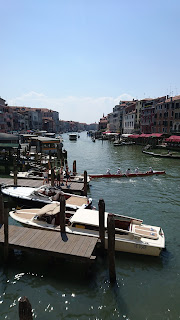There are places I remember. All my life, though some have changed. All these places have their moments, with lovers and friends I still can recall...

Moving around is on foot or by boat on the canals. Burano was probably founded by the Romans in the 6th century and was in the shadows of
Murano and Torcello until the 16th century, when the women on the island began making lace with needles. Today it is a thriving island.
Burano is well known for it's leaning bell tower, San Martino Church dates from the 15th century and stands at 53 mtr and has an incline to it's axis of 1.83mtr.
A beautiful island only 21 hectares, and 14,000 residents. We hop back on the Venetian ferry buses and head towards Murano our next stop


About a 30 minute trip from Burano by ferry, is a another beautiful island. Famous for its glass making. This came about because the Venetian Republic fearing fire and destruction of the city due to it's many wooden buildings, ordered the glass maker to move to the Murano in 1291.
The glass makers became prominent citizens and had special privileges, as they could wear swords and had immunity from prosecution. No wonder the daughters married into Venice's wealthy families.
It was fascinating to watch glass blowing.
A great skill
 |
| Glassmaker at work |
Walking around Burano and Murano was like stepping back in time. With lace making, glass blowing and many other cottage type industries evident throughout these communities, was uplifting. Add this to warm sunny weather, lovely canals, architecture and pace of life, it seemed idyllic.

Time to move back on the ferry and head to Venetia, here we come.
 |
| Gondolas everywhere.... |
The view on the left is from the Bridge of Sighs. It is hard to believe the way Venice is constructed on wooden piles, despite centuries of submersion. The foundations rest on plates of Istrian limestone placed on top of the piles, and buildings of brick or stone sit above these footings. The piles penetrate a softer layer of sand and mud until they reach a much harder layer of compressed clay.
You are surrounded in Piazza San Marco by some of the most fascinating buildings you will see anywhere.


St Mark's Basilica, Doge's Palace. This is the principal public square of Venice.
Venice was a major financial and maritime power during the Middle Ages and Renaissance period. It was also a very important centre for commerce.(Silk, grain & spice).

The central focus for me is Piazza San Marco, a wonderful vibrant meeting place surrounded by beautiful buildings, music, places to eat etc.
Like all great historical centres, declines come and go. Venice started to decline in the 15th century. During the plagues they lost a third of their population.
During the 20th century artisan wells were sunk to supply water for local industry. It was realised that Venice began to subside, so the wells were prohibited from the 1960's. However the city continues to sink at 1-2mm pa. Subsidence is part of Venetian life, this lowering of the surface of Venice is called Aqua Alta and each season much of the surface of the Venice is covered by a high tide.
Venice was a major financial and maritime power during the Middle Ages and Renaissance period. It was also a very important centre for commerce.(Silk, grain & spice).

The central focus for me is Piazza San Marco, a wonderful vibrant meeting place surrounded by beautiful buildings, music, places to eat etc.
Like all great historical centres, declines come and go. Venice started to decline in the 15th century. During the plagues they lost a third of their population.
During the 20th century artisan wells were sunk to supply water for local industry. It was realised that Venice began to subside, so the wells were prohibited from the 1960's. However the city continues to sink at 1-2mm pa. Subsidence is part of Venetian life, this lowering of the surface of Venice is called Aqua Alta and each season much of the surface of the Venice is covered by a high tide.
 |
| One of the entrances to include a series of hollow pontoons |
When Prime Minister, Silvio Berlusconi inaugurated the Mose project , an experimental model for evaluating the performance of hollow floatable gates; the idea is to fix a series of 78 hollow pontoons to the sea bed across the three entrances to the lagoon. When tides are predicted to rise above 110 centimetres, the pontoons will be filled with air, causing them to float and block the incoming water from the Adriatic Sea. This engineering work is due to be completed by 2018
Peter on the famous Rialto Bridge, Grand Canal
Two more Aussie tourists on the famous bridge which was opened in 1591 just before Paul & Garry were born. This bridge divides two districts, San Marco & San Polo.
 |
| Rialto Bridge |
 |
| Some music with your espresso Signore? |
Did you know Venezuela means "Little Venice?"
















No comments:
Post a Comment